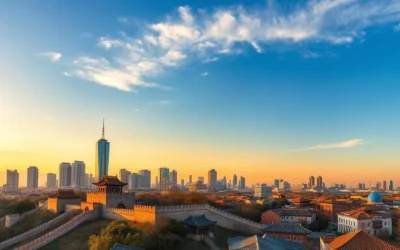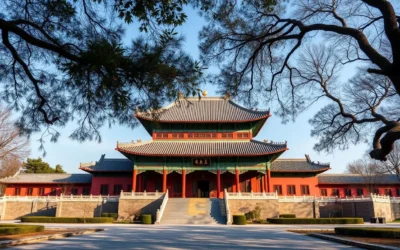✓ Accommodations✓ Flights✓ Rental Cars
Shanxi is a region rich in history and culture, offering a unique blend of ancient traditions and modern celebrations. From the lively Spring Festival to the colorful Lantern Festival, this area is a treasure trove of cultural experiences. Whether you’re planning a tour or simply want to explore the local heritage, Shanxi’s festivals provide a perfect opportunity to immerse yourself in its vibrant culture.
The Spring Festival, celebrated on the 1st day of the 1st lunar month, marks the beginning of the new year and is one of the most important events in the region. Another highlight is the Lantern Festival, held on the 15th day of the 1st lunar month, which lights up the city with stunning displays and traditional performances. These events not only showcase the region’s rich heritage but also bring communities together in joyous celebration.
Exploring Shanxi during these festivals allows you to witness its UNESCO World Heritage Sites, such as the Pingyao Ancient City and Yungang Grottoes, in a whole new light. The blend of history and festivity creates an unforgettable travel experience. So, pack your bags and get ready to discover the heart of this culturally rich region.
Discover the Vibrant Culture of Shanxi Festivals
Step into a world where ancient traditions come alive during vibrant celebrations. These events are deeply rooted in history, offering a glimpse into the region’s rich cultural heritage. From ancient murals to UNESCO-listed sites, every festival tells a story of the past and present.
Historical Background and Cultural Significance
Festivals in this region are more than just celebrations; they are a reflection of centuries-old traditions. Ancient murals dating back to the Eastern Han Dynasty showcase the artistic legacy that influences these events. Temples and UNESCO cities like Pingyao add to the historical charm, making every festival a journey through time.
For example, the Spring Festival, celebrated on the 1st day of the 1st lunar month, is a time for family reunions and cultural rituals. Families paste Spring Festival couplets on doors and burn firecrackers to welcome the New Year. These customs symbolize prosperity and the expulsion of negativity, creating a festive atmosphere that resonates with everyone.
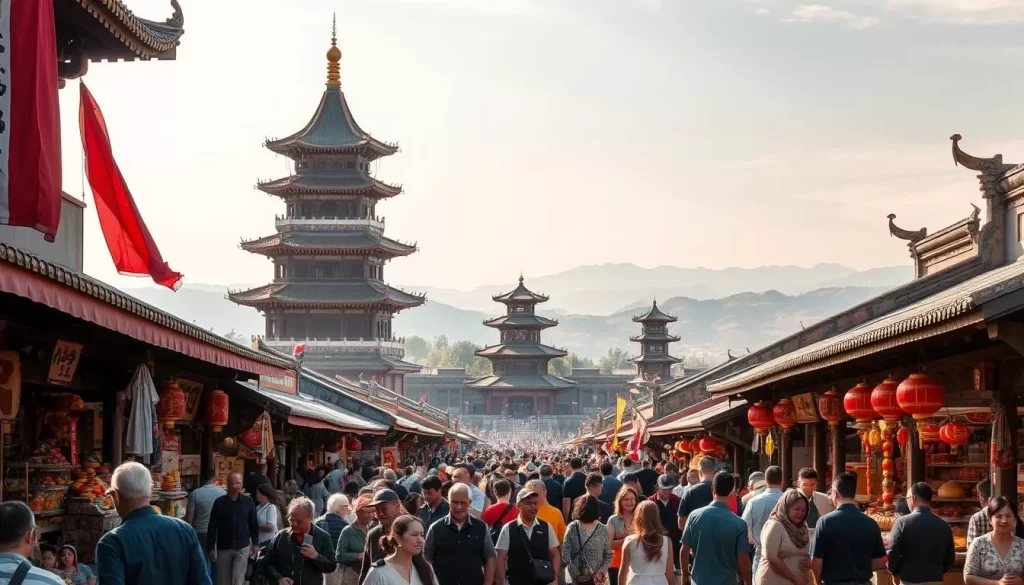
Overview of Regional Festival Celebrations
Regional festivals are a blend of history and modern celebration. The Dragon Boat Festival, held on May 31, 2025, is a public holiday that features boat races and traditional food. Another highlight is the Mid-Autumn Festival, celebrated on October 6, 2025, marking the end of the harvest season with mooncakes and lantern displays.
In Pingyao Ancient City, the Shehuo Show during the Chinese New Year Festival includes stilt shows and Yangko dance performances. These activities not only entertain but also preserve the region’s cultural identity. Whether you’re exploring ancient temples or enjoying modern festivities, every event offers a unique experience.
| Festival | Date | Highlights |
|---|---|---|
| Spring Festival | February 17, 2026 | Family reunions, firecrackers, temple fairs |
| Dragon Boat Festival | May 31, 2025 | Boat races, traditional food |
| Mid-Autumn Festival | October 6, 2025 | Mooncakes, lantern displays |
These festivals are not just events; they are a guide to understanding the region’s cultural depth. Whether you’re visiting an ancient city or enjoying a modern celebration, every moment is an attraction that brings history to life.
Shaanxi Province, China: Top Festivals to Check Out When Visiting
Discover the heart of Shanxi through its festivals, where ancient traditions meet modern celebrations. Each event offers a unique experience, allowing you to connect with the region’s rich culture and history. Whether you’re a first-time tourist or a seasoned traveler, these festivals provide a perfect guide to understanding the local way of life.

Festival Highlights Across the Region
From the Spring Festival to the Lantern Festival, each celebration has its own charm. The Spring Festival, held on the 1st day of the 1st lunar month, is a time for family reunions and cultural rituals. The Lantern Festival, celebrated on the 15th day of the 1st lunar month, lights up the region with stunning displays.
Another highlight is the Dragon Boat Festival, featuring boat races and traditional food on the 5th day of the 5th lunar month. These events not only entertain but also preserve the region’s cultural identity.
Authentic Experiences You Can’t Miss
For an immersive tour, explore Buddhist civilization sites and merchant heritage compounds. These locations offer a glimpse into the region’s historical and religious significance. The Qingming Festival, held from April 4-6, is a perfect time to visit these sites.
Don’t miss the Sister’s Meal Festival, celebrated on the 15th day of the third lunar month. This three-day event showcases local traditions and vibrant performances.
| Festival | Date | Highlights |
|---|---|---|
| Spring Festival | February 17, 2026 | Family reunions, firecrackers, temple fairs |
| Dragon Boat Festival | May 31, 2025 | Boat races, traditional food |
| Mid-Autumn Festival | October 6, 2025 | Mooncakes, lantern displays |
These festivals are more than just events; they are a guide to understanding the region’s cultural depth. Whether you’re exploring ancient temples or enjoying modern celebrations, every moment is an attraction that brings history to life.
Celebrate Chinese New Year and Spring Festival Traditions
Immerse yourself in the vibrant traditions of the Chinese New Year and Spring Festival, where history and celebration intertwine. These events are a time for family, joy, and cultural richness, offering a unique glimpse into ancient customs that continue to thrive today.
Temple Fairs and Lantern Displays
One of the highlights of the Chinese New Year is the temple fairs. These fairs are bustling with activity, featuring traditional performances, local crafts, and delicious food. They provide a perfect opportunity to experience the region’s folk culture firsthand.
Another must-see is the Lantern Festival, which marks the end of the Chinese New Year celebrations. Held on the first full moon after the new year, this event lights up the region with stunning lantern displays. Families gather to admire the colorful creations, making it a truly magical experience.
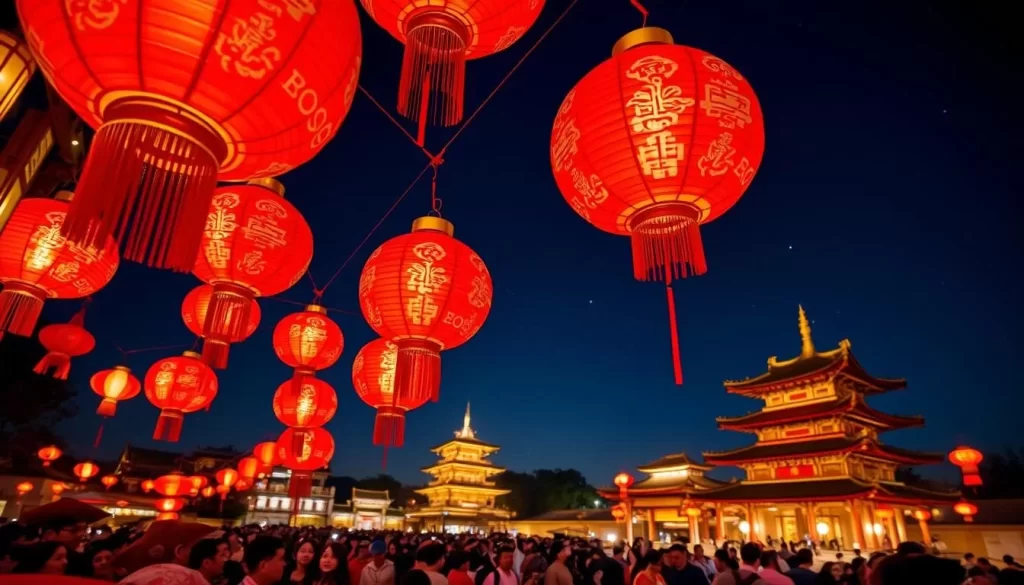
Interactive Activities and Traditional Crafts
During the Spring Festival, you can participate in various interactive activities. From making dumplings to crafting traditional lanterns, these hands-on experiences allow you to connect with the culture in a meaningful way.
Dragon dances and dramatic drum performances are also common during this time. These activities not only entertain but also preserve the region’s cultural identity. Whether you’re exploring ancient cities or enjoying modern festivities, every moment is an attraction that brings history to life.
| Activity | Location | Highlights |
|---|---|---|
| Temple Fairs | Xinzhou Ancient City | Traditional performances, local crafts |
| Lantern Displays | Huangcheng Chancellor’s House | Colorful lanterns, family gatherings |
| Dragon Dances | Various Locations | Dramatic performances, cultural preservation |
These traditions are more than just events; they are a guide to understanding the region’s cultural depth. Whether you’re making dumplings or admiring lanterns, every activity offers a unique way to celebrate the Chinese New Year and Spring Festival.
Experience Local Culinary Delights and Festive Treats
Shanxi’s culinary scene is a vibrant tapestry of flavors, blending tradition with festive cheer. During festivals, the region comes alive with signature dishes and street food that capture the essence of its culture. Whether you’re exploring bustling markets or dining in cozy family restaurants, every bite tells a story.
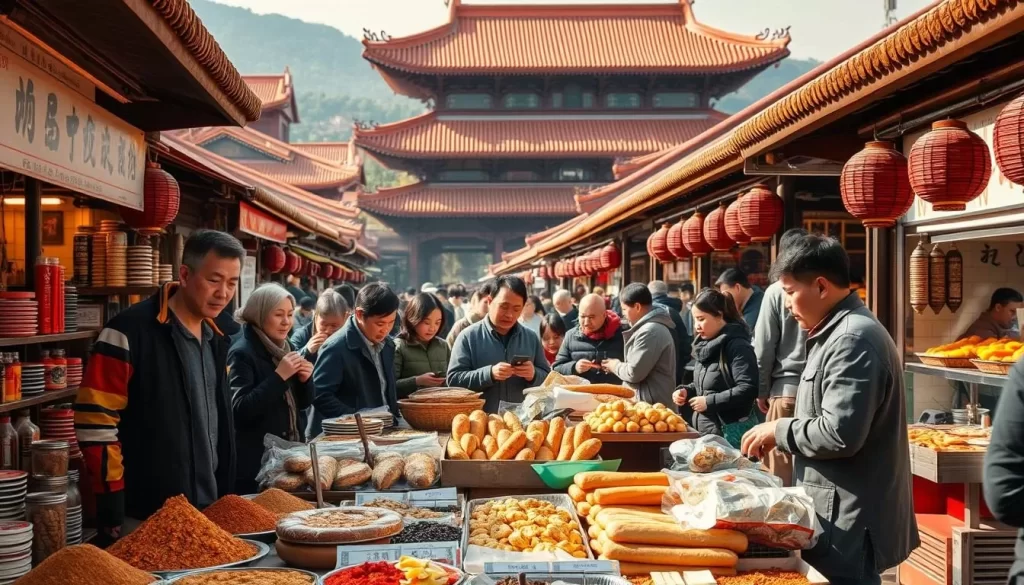
Signature Dishes to Savor During Festivals
One of the highlights of Shanxi’s cuisine is Datong Sliced Noodles, a dish that combines hand-pulled noodles with savory broth and toppings. Another must-try is guoyourou, a crispy pork dish that’s a favorite during celebrations. These dishes are often enjoyed with family, making them a cherished part of the festival experience.
Street Food, Snacks, and Seasonal Flavors
Street food stalls offer a variety of treats that reflect the region’s culinary diversity. Roujiamo, often called the Chinese hamburger, is a popular choice, while Yangrou Paomo, a mutton soup with flatbread, warms the soul on chilly days. Seasonal flavors also play a big role, with dishes like persimmon cakes in autumn and hot pot in winter.
| Dish | Season | Description |
|---|---|---|
| Datong Sliced Noodles | Year-round | Hand-pulled noodles with savory broth |
| Guoyourou | Festivals | Crispy pork dish |
| Roujiamo | Year-round | Chinese hamburger |
| Yangrou Paomo | Winter | Mutton soup with flatbread |
Exploring Shanxi’s culinary delights is a guide to understanding its culture. From street food to family recipes, every dish is a part of the region’s rich heritage. So, grab a ticket to this flavorful journey and savor the tastes of the city.
Explore Historic Sites and Cultural Landmarks
Step back in time and explore the architectural marvels that define this culturally rich region. From ancient temples to merchant courtyards, every landmark tells a story of prosperity and heritage.
Ancient Temples, Pagodas, and Grottoes
Discover the spiritual heart of the region through its ancient temples and pagodas. The Yungang Grottoes, a UNESCO World Heritage site, feature over 51,000 sculptures carved between 460 AD and 524 AD. Another must-see is the Hanging Temple, built nearly 50 meters above the ground over 1,500 years ago.
Mount Wutai, a sacred Buddhist site, is home to 47 temples and is a significant pilgrimage destination. These sites not only showcase religious devotion but also highlight the region’s artistic and architectural brilliance.
Merchant Courtyards and Architectural Wonders
Step into the world of prosperous merchants at Qiao’s and Wang’s Family Compounds. Qiao’s Family Compound, built in 1756, features 6 major courtyards and 313 rooms. Wang’s Family Compound spans 250,000 square meters with 35 courtyards and 342 houses.
These courtyards reflect the wealth and influence of merchants during the Ming and Qing Dynasties. Their intricate designs and expansive layouts make them a scenic spot for history enthusiasts.
For more insights into the region’s history, visit the Shaanxi History Museum, which houses over 500,000 cultural artifacts. Or explore the ancient city of Pingyao, protected by a 6,163-meter-long city wall.
Navigating Shanxi: Transportation, Accommodation, and Travel Tips
Planning your trip to Shanxi? Here’s everything you need to know about getting around and finding the perfect place to stay. Whether you’re traveling solo or with family, these tips will make your journey smooth and enjoyable.
How to Get There and Around
Shanxi is well-connected by air, rail, and road. The main airport, Taiyuan Wusu International Airport, offers flights from major cities. High-speed trains are a convenient way to reach destinations like Datong and Pingyao.
For local transportation, buses and taxis are widely available. If you prefer flexibility, consider renting a car. This allows you to explore at your own pace and visit remote places like the Hanging Temple.
Finding the Best Places to Stay
Shanxi offers a range of accommodations to suit every budget. From luxury hotels to cozy guesthouses, you’ll find the perfect place to rest after a day of exploring. In Pingyao, stay at traditional courtyard hotels for an authentic experience.
Booking in advance is recommended, especially during peak travel time. Use trusted platforms to secure your stay and check reviews for insights from other travelers.
| Transportation Option | Details | Tips |
|---|---|---|
| Flights | Arrive at Taiyuan Wusu International Airport | Book early for better deals |
| High-Speed Trains | Connect to Datong, Pingyao, and more | Purchase tickets online |
| Local Buses | Affordable and widely available | Check schedules in advance |
| Car Rentals | Ideal for exploring remote areas | Bring a valid driver’s license |
For more detailed itineraries, check out this 6-day trip guide. It covers must-visit sites and practical tips for a memorable journey.
If you’re planning to visit the Hanging Temple, this guide offers valuable advice on securing tickets and making the most of your visit.
With these tips, your trip to Shanxi will be a seamless and enriching activity. Enjoy every part of your adventure!
Engage with Unique Folk Customs and Art Performances
Dive into the heart of cultural traditions with unique folk customs and art performances. These vibrant expressions of heritage offer a window into the soul of the region, blending history with creativity. Whether you’re a seasoned traveler or a first-time visitor, these experiences will leave a lasting impression.
Local Dances, Music, and Traditional Dramas
Experience the rhythm of the region through traditional dances and music. The Yangko dance, recognized as part of China’s National Intangible Cultural Heritage since 2008, is a highlight during the Chinese New Year celebrations. This lively performance, often accompanied by drums and flutes, brings communities together in joyous celebration.
Another must-see is Qin Opera, one of the oldest operas in the region, reflecting profound historical and cultural heritage. These performances are not just entertainment; they are a guide to understanding the region’s rich traditions.
Immersive Cultural Workshops and Demonstrations
For a hands-on experience, participate in cultural workshops that teach traditional crafts and performance art. Learn the delicate art of paper cutting, a craft noted for its vivid subject matter and intricate designs. These workshops are a perfect way to connect with the local culture and create your own souvenirs.
You can also explore shadow puppetry, renowned for its exquisite craftsmanship and vivid performances. These immersive activities are a travel highlight, offering a deeper appreciation for the region’s artistic legacy.
For more insights into traditional dance and cultural activities, visit this guide. Or, learn about vibrant folk celebrations during the Mid-Autumn Festival here.
Conclusion
Celebrate the spirit of tradition and modernity with a journey through vibrant cultural events. From the Spring Festival to lantern displays, every celebration offers a unique experience that connects you to the region’s rich heritage. Whether you’re planning a tour or seeking a memorable holiday, these festivals provide a perfect way to explore local customs.
Plan your trip to include visits to ancient cities and bustling markets. Enjoy traditional dances, hands-on workshops, and delicious cuisine. For more inspiration, discover Shaanxi’s allure and create a personalized itinerary that suits your interests.
With its blend of history and festivity, this region promises an unforgettable travel adventure. Pack your bags and get ready to explore a place where every day feels like a celebration.
The above is subject to change.
Check back often to TRAVEL.COM for the latest travel tips and deals.

